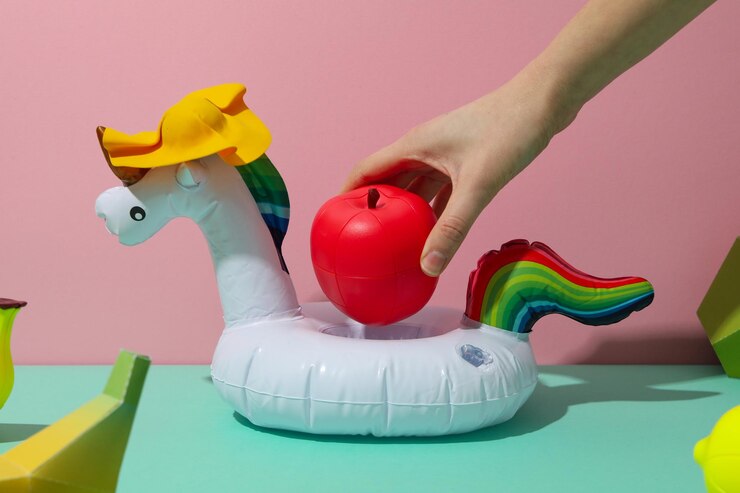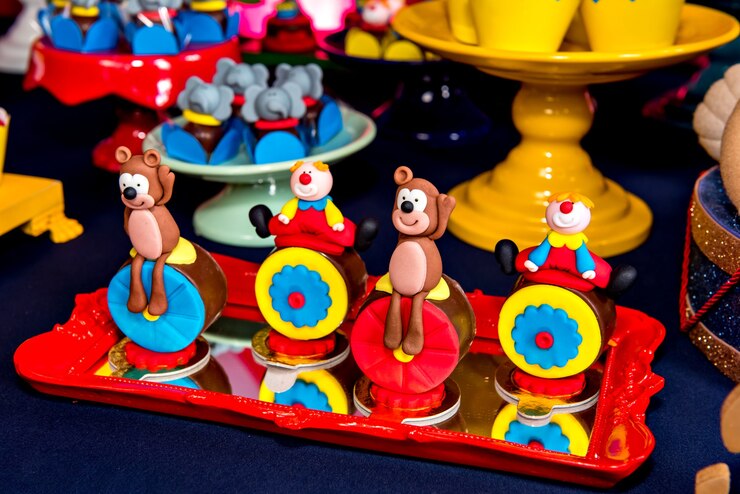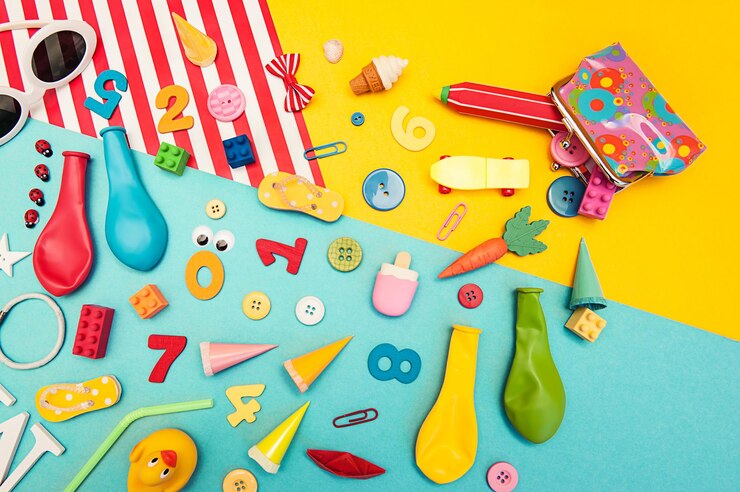The Development Of Toys – Now And In The Future
How have toys evolved over time? The changing mission of toys reflects changes in technology, culture, and children’s development and participation in the process of growing and learning. In 2024, the global toy industry was valued at more than $113 billion, vividly reflecting the changes in culture, technology, and society; the industry is expected to grow further by mid-2025, reaching a market size of $196.3 billion by 2033, reflecting the current toy economy trends. Toys are no longer just playthings for children; they are tools for learning, expressions of personality, and even collectible investments for adults.
Hot toy trends, such as interactive, educational, and technology-enhanced toys, also look forward to future innovations, such as artificial intelligence toys, VR integration, and sustainable and environmentally friendly materials. Explore their importance, driving forces, and explore their importance, driving forces, and the evolution of toys continues to adapt to children’s needs, safety standards, and parents’ expectations, and promises to provide more engaging, personalized, and responsible choices in the coming years.
Looking At Toy Trends: Demand And Adaptability Matter
Toys shape how children learn, grow and interact with the world. For parents, choosing the right toy can foster skills such as problem-solving, emotional intelligence or environmental awareness. How current toy trends are shaped by consumer demand and the industry’s ability to adapt to changing preferences. For collectors, toys offer a way to evoke nostalgia or invest in rare items. Factors include the growing popularity of educational and STEM toys, the increasing focus on inclusivity and diversity in toy design, and the impact of digital transformation on traditional play.
Toy trends for 2024-2026 reflect a blend of innovation and tradition, according to industry reports such as the Nuremberg 2025 Toy Fair and the Toy Association. Meeting diverse needs – How toy manufacturers respond to sudden trends, the influence of social media, and global events shows that staying adaptable is key to long-term success in the competitive toy market.
Summary and Outlook 2024-2026: Past, Present & Top 10 Toy Trends
1. Kidults and the Adult Toy Market
The rise of “kidults”—adults purchasing toys for themselves—is reshaping the industry. Research suggests this segment accounts for nearly 30% of global toy market revenue, with growth expected through 2026. Driven by nostalgia, stress relief, and the allure of collectibles, kidults are drawn to sophisticated toys like the LEGO Ideas JAWS set or Hasbro’s collectible action figures. For example, LEGO’s 23% profit margin in 2020 highlights its success in targeting adults with complex, screen-free builds. This trend reflects a broader societal need for relaxation and connection to childhood memories.
2. Sustainable and Eco-Friendly Toys
Sustainability is no longer a niche; it’s a necessity. The eco-friendly toys market, valued at $1.2 billion in 2024, is projected to grow at a 12.5% CAGR through 2034. Parents are increasingly choosing toys made from recycled plastics, bamboo, or sustainably sourced wood to teach children about environmental responsibility. PlanToys, for instance, uses rubberwood and non-toxic dyes, while Green Toys transforms recycled milk jugs into durable playthings. These toys align with the 75% of millennial parents who prefer sustainable brands.
3. Personalized and Customizable Toys
Personalization is a growing trend, with 69% of parents influenced by toys seen online or via influencers. Toys like Mattel’s ThingMaker or LEGO Custom Sets allow children to design their own figures, fostering creativity and individuality. Technologies like 3D printing and AI-driven customization make this possible, creating emotional connections through unique play experiences. This trend caters to parents who want toys that reflect their child’s personality.
4. AI and Smart Toys
Artificial intelligence is transforming play by offering interactive and educational experiences. AI toys, which make up 75% of the market in 2025 (up from 5% in 2000), include intelligent companions like the PLAi Poe The Ai Story Bear, which adapts to a child’s learning pace. These toys support parents’ desires for educational value, with 60% seeking STEAM-focused toys. However, concerns about data privacy remain, requiring careful consideration when choosing AI toys.
5. AR/VR and Immersive Play
Augmented and virtual reality toys bridge physical and digital play, enhancing engagement and learning. Products like the Merge Cube or Osmo’s interactive games create immersive experiences that captivate children. These toys align with the trend of blending technology with traditional play, appealing to tech-savvy families while promoting social interaction and creativity.
6. Educational Toys: STEM and Beyond
Educational toys are a priority, with 58% of parents favoring toys that build skills and 63% of millennial parents seeking toys that promote mental, emotional, and social health. STEM toys like the Snap Circuits Spy Kit or LEGO Technic Planet Earth and Moon in Orbit encourage coding, science, and creativity. Beyond STEM, toys like gender-neutral dolls or emotional regulation plushies foster empathy and inclusivity. These toys prepare children for future challenges while making learning fun.
7. Licensed Toys from Entertainment
Licensed toys tied to movies, games, and anime dominate the market, accounting for 32% of global sales. Recent releases like Mattel’s Moana 2 Voyager Two-Doll Set or Hasbro’s Spider-Man VenomVersus Liquid Shifter Action Figure capitalize on popular franchises. These toys allow children to engage with beloved characters, driving demand and reflecting the influence of media on play preferences.
8. Collectible Toys
Collectibles are booming, with sales growing nearly 5% globally in 2024. The thrill of collecting, trading, and discovering rare items appeals to both children and adults. Pop Mart’s blind box toys, such as the Labubu or Molly series, have elevated toy-buying to an art form, with some figures fetching high prices on the second-hand market. Other examples include LEGO Minifigures Dungeons & Dragons and Disney Lacers.
9. Subscription-Based Toy Services
Subscription models are redefining toy consumption, with a projected 12.1% CAGR through 2030. Services like Lovevery and KiwiCo deliver curated, age-appropriate toys that reduce clutter and keep playtime fresh. These models appeal to parents seeking convenience and sustainability, aligning with modern parenting needs.
10. Nostalgia and Retro Toys
Nostalgia-driven toys, or “newstalgia,” blend classic designs with modern twists. With 73% of parents buying toys for themselves to relive memories, re-releases like the 12” Rainbow Brite Doll or retro board games with digital layers are popular. These toys bridge generational gaps, appealing to both kids and adults.

Trends Represent Drivers | Customized And Retro Toys
Emerging trends driving innovation and consumer interest in the toy industry focus on customized and retro toys. Personalization, such as custom action figures, personalized name dolls, or custom designer sets, appeals to modern consumers who seek unique experiences. The resurgence of retro toys taps into nostalgia, appealing to adults and children alike. Reflecting broader cultural shifts, it is a powerful driver of sales, brand loyalty, and cross-generational appeal. Customized toys offer a personalized experience, satisfying children’s desire for individuality.
This trend fosters creativity and emotional connection as children feel a sense of ownership over their creations. For parents, customized toys align with the 69% of parents who are influenced by social media-driven personalization[1]. Retro toys are truly a trend driven by nostalgia and a desire for simplicity. The National Toy Association says 61% of parents buy retro toys to connect with their children[1]. In a fast-paced world, there is a cultural shift toward durability and timeless play experiences.
Want New Kid-friendly Toys? – You Won’t Be Disappointed In 2025
While exact numbers are hard to pin down, the toy industry launches thousands of new products every year. How upcoming toys will focus on safety, education, creativity, and fun. Parents can expect more eco-friendly materials, interactive learning features, and technology that encourages active play while minimizing screen time. Trends such as STEM-based sets, inclusive characters, and customizable designs will make toys more appealing to children of different ages and interests. With these innovations, 2025 will bring colorful and fun options for children. There will be a wide range of children’s toys. From educational toys to collectibles, the sheer number reflects the industry’s innovative strength.
Toys Are Changing, What Do Kids Really Want?
Toys today are very different from those of a few years ago. As times change, so do children’s interests and needs. Children’s preferences vary, but trends show that they have a strong interest in interactive, educational, and collectible toys. Many children like toys that they can learn while playing. STEM toys (science, technology, engineering, and mathematics) are becoming more and more popular. They help children solve problems, develop creative thinking, and develop important skills needed for the future. Make your own toy figures, design dolls, or create your own game levels. Personalized toys make children feel special and allow them to fully tap into their creativity.
Toys that represent different cultures, abilities, and family structures make children feel valued and included. This trend helps children learn empathy and acceptance from an early age. Toys with surprise elements, such as Pop Mart’s blind boxes, are also popular. As toys continue to change, children want more than just fun. They like toys that challenge their minds, reflect themselves, and help them grow. The future of toys is bright, with endless possibilities for learning, creation, and joy.
Trend Summary: Key Toy Trends In 2024-2025
The toy industry is constantly evolving, reflecting children’s interests and parents’ expectations. The top toy trends for 2024-2025 are shaping how children play and have fun. Educational and STEM toys help children develop problem-solving skills, creativity, and curiosity. Parents love them because they combine fun with valuable learning experiences. Smart, interactive toys that talk, react, and adjust to how children play make playtime more engaging. Customizable dolls, action figures, and building sets allow children to design and create unique items. Personalization makes play more meaningful and allows children to use their creativity.
Classic games, retro action figures, and vintage dolls are given a modern upgrade to create shared play experiences across generations. Sensory toys and mindful play help children relax, focus, and develop emotional awareness, providing entertainment while promoting physical and mental health. Showing a balance between fun, education, technology, and social values, the toy trends for 2024-2025 will be marked by innovation and diversity. trends such as “Animation with Friends” and “Healthy Heroes”, and launched new products such as the LEGO Dubrovnik “Family Cabin” and Playmobil “Haunted Ruins” [2].
New Toys Launching? – Uncertainty In 2026
The toy industry introduces new products every year, however, 2026 also brings some uncertainty. Changes in consumer preferences make it harder for toy manufacturers to predict what kids will want. The global economic situation could affect toy production and sales. Supply chain issues seen in recent years could continue into 2026. Shipping delays, material shortages, or factory shutdowns could slow toys to market. New technologies bring both opportunities and challenges, and innovation must strike a balance between safety, privacy, and affordability.
Environmentally friendly materials and reduced waste are required. Toy safety regulations are stricter, especially for tech toys that collect data or connect to the internet. Companies need to strictly comply with these regulations to avoid legal or reputational issues. The specific products on the market are uncertain, but trends suggest that artificial intelligence, sustainability, and licensed toys will continue to grow. Expect more advanced smart toys, more environmentally friendly designs, and tie-in products related to upcoming movies and games in the future.
Merchant & Product Recommendations – Get Rid of Choice Confusion
To bring these trends to life, here are two toys from two merchants that embody the direction of industry development:
- PlanToys is committed to sustainability and provides eco-friendly wooden toys that help children develop.
- PlanToys Ramp Racer: Made from sustainable rubberwood, this eco-friendly wooden toy develops children’s motor skills and imagination. For parents looking for durable and eco-friendly toys, PlanToys is the ideal choice.
- Pop Mart: As a leader in the collectible toy market, the blind box model has revolutionized toy shopping and made it a fashionable choice for collectors.
- Pop Mart Rab Blind Box: These collectible designer toys are full of surprises that adults and children will love. Their unique design and rarity make them a must-have for collectors.

Toy Trends: Reflecting The Change In How Fun Is Accessed
The way children experience fun has changed over time, and today’s toy trends show that fun is no longer limited to entertainment. Play now encompasses learning, creativity, teamwork, emotional growth, and personal expression. There will continue to be new and exciting ways for children to have fun while growing and learning. Toy trends for 2024-2026 showcase the future of play, blending innovation with timeless appeal.
From sustainable toys that foster environmental responsibility to AI-powered toys that enhance learning, these trends address diverse needs and desires. For parents, choosing toys that align with these trends can foster creativity, education, and joy in their children. For collectors, the rise of Kidults and collectibles presents exciting opportunities.


